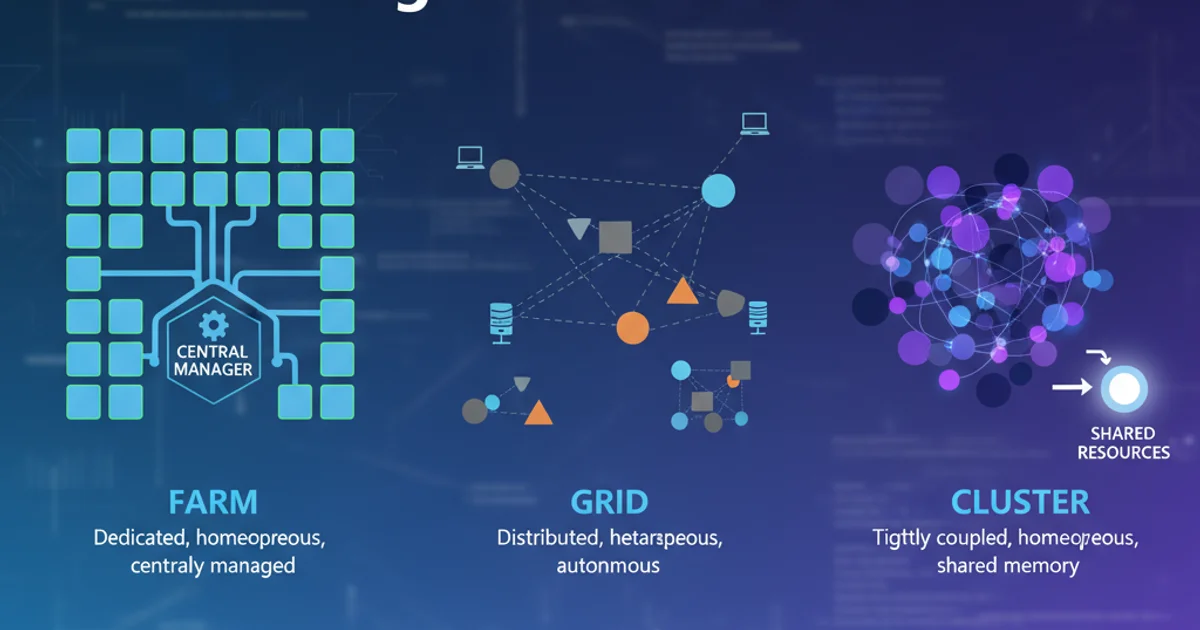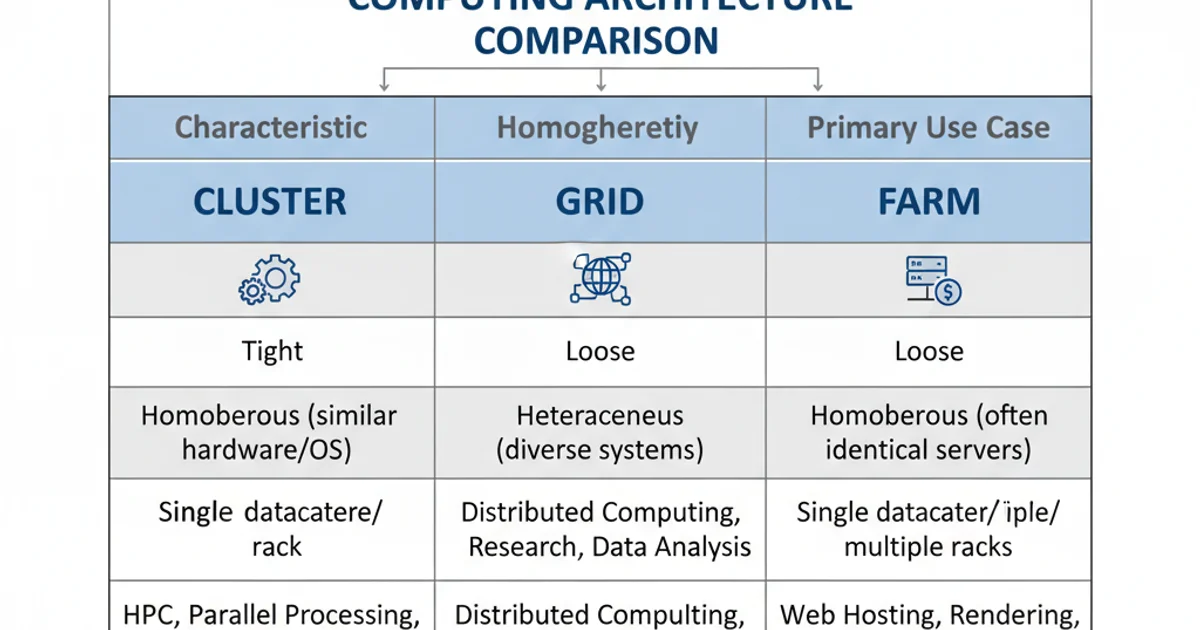What is a farm, as opposed to a grid or a cluster?
Categories:
Farm vs. Grid vs. Cluster: Understanding Distributed Computing Architectures

Explore the distinctions between computing farms, grids, and clusters to better understand their applications in parallel and distributed processing.
In the realm of parallel and distributed computing, terms like 'farm,' 'grid,' and 'cluster' are frequently used to describe different architectures for combining computational resources. While they all aim to leverage multiple machines for increased processing power or reliability, their underlying philosophies, structures, and use cases differ significantly. Understanding these distinctions is crucial for designing and implementing efficient distributed systems.
What is a Computing Cluster?
A computing cluster is a group of tightly coupled, interconnected computers that work together as a single, unified computing resource. Typically, all machines in a cluster are homogeneous (or nearly so), located in close proximity (e.g., within the same data center or rack), and managed by a centralized scheduler or operating system. Clusters are designed for high performance and high availability, often used for parallel processing tasks where nodes need to communicate frequently and rapidly. They share resources like storage and network infrastructure, presenting a single system image to the user.
graph TD
subgraph Cluster
A[Node 1] --> B(Shared Storage)
A --> C(High-Speed Interconnect)
B --> C
C --> D[Node 2]
C --> E[Node 3]
D --> B
E --> B
end
F[Centralized Scheduler] --> A
F --> D
F --> E
F --> B
F --> C
G[User/Application] --> FArchitecture of a typical computing cluster with centralized management and shared resources.
What is a Computing Grid?
A computing grid, often referred to as 'grid computing,' is a distributed system that aggregates geographically dispersed and often heterogeneous computing resources. Unlike clusters, grid nodes are loosely coupled, may belong to different administrative domains, and are typically connected over wide-area networks. The primary goal of a grid is to enable resource sharing and collaboration across organizations, allowing users to access computing power, storage, and data from various sources as if it were a single, massive virtual computer. Grid computing often involves middleware that handles resource discovery, scheduling, and security across diverse environments.
graph TD
subgraph Domain A
A[Cluster 1] --> B(Resource Pool A)
end
subgraph Domain B
C[Workstation 1] --> D(Resource Pool B)
E[Server Farm 1] --> D
end
subgraph Domain C
F[HPC System] --> G(Resource Pool C)
end
H[Grid Middleware] --> A
H --> C
H --> E
H --> F
I[User/Application] --> H
B -- WAN --> H
D -- WAN --> H
G -- WAN --> HConceptual diagram of a computing grid connecting diverse resources across different administrative domains.
What is a Computing Farm?
The term 'computing farm' or 'server farm' is generally less formally defined than cluster or grid. It typically refers to a collection of servers, often homogeneous, housed in a single location (like a data center) that are dedicated to performing a specific type of task or serving a particular application. Unlike a cluster, the nodes in a farm might not be tightly coupled or present a single system image. Instead, they often operate independently, processing requests in parallel, with a load balancer distributing incoming work among them. Web farms, render farms, and database farms are common examples. The emphasis is on scalability and throughput for a specific service rather than unified high-performance computing.
graph TD
A[Client Request] --> B(Load Balancer)
B --> C[Web Server 1]
B --> D[Web Server 2]
B --> E[Web Server 3]
C --> F(Shared Database)
D --> F
E --> F
subgraph Web Farm
C
D
E
endIllustration of a web farm with a load balancer distributing client requests among multiple web servers.
Key Differences and Use Cases
The primary distinctions lie in their coupling, homogeneity, geographical distribution, and management. Clusters are tightly coupled, homogeneous, localized, and centrally managed for HPC. Grids are loosely coupled, heterogeneous, geographically distributed, and managed by middleware for large-scale, independent tasks. Farms are collections of servers, often homogeneous and localized, managed by a load balancer for specific service scalability. Choosing the right architecture depends entirely on the application's requirements for performance, scalability, resource sharing, and fault tolerance.

Comparative overview of Cluster, Grid, and Farm characteristics.